KIA Sorento 2006 1.G Service Manual
Manufacturer: KIA, Model Year: 2006, Model line: Sorento, Model: KIA Sorento 2006 1.GPages: 312, PDF Size: 5.21 MB
Page 41 of 312

3 Point Rear Center Belt
(If equipped)
To fasten the rear center belt
1. Slowly pull the tongue plates out
from the retractor.
KNOWING YOUR VEHICLE3-32
S2BLB302Z
WARNING -
Safety Belts
The seatbacks should always
remain in a comfortable,
upright position while the
vehicle is in motion. The safe-
ty belt system will provide the
most protection with the seat-
backs in an upright position.
Never wear the shoulder por-
tion of the safety belt under
the outside arm or behind the
back.
Never wear the shoulder por-
tion of the safety belt across
the neck or face.
Wear the lap portion of the
safety belt as low as possible.
Be sure the lap belt fits snug-
ly around the hips. Never wear
the lap belt over your waist.
Make sure the safety belts are
not twisted while in use.
(Continued)
(Continued)
Never use a single belt to
restrain more than one person
at a time.
Failure to follow these warnings
will increase the chance and
severity of injury in an accident.
BL-ENG (CAN)-3.qxd 7/28/05 5:52 PM Page 32
Page 42 of 312
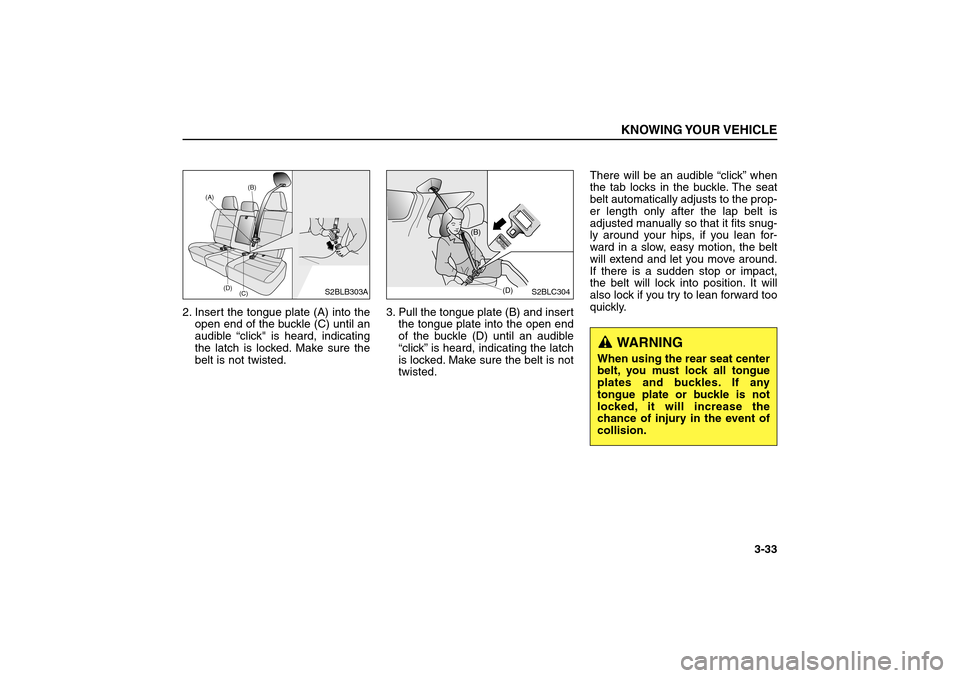
2. Insert the tongue plate (A) into the
open end of the buckle (C) until an
audible “click" is heard, indicating
the latch is locked. Make sure the
belt is not twisted.3. Pull the tongue plate (B) and insert
the tongue plate into the open end
of the buckle (D) until an audible
“click”is heard, indicating the latch
is locked. Make sure the belt is not
twisted.There will be an audible “click”when
the tab locks in the buckle. The seat
belt automatically adjusts to the prop-
er length only after the lap belt is
adjusted manually so that it fits snug-
ly around your hips, if you lean for-
ward in a slow, easy motion, the belt
will extend and let you move around.
If there is a sudden stop or impact,
the belt will lock into position. It will
also lock if you try to lean forward too
quickly.
KNOWING YOUR VEHICLE
3-33
(D) (A)
(C)(B)
S2BLB303A
(D) (B)PRESS
S2BLC304
WARNING
When using the rear seat center
belt, you must lock all tongue
plates and buckles. If any
tongue plate or buckle is not
locked, it will increase the
chance of injury in the event of
collision.
BL-ENG (CAN)-3.qxd 7/28/05 5:52 PM Page 33
Page 43 of 312
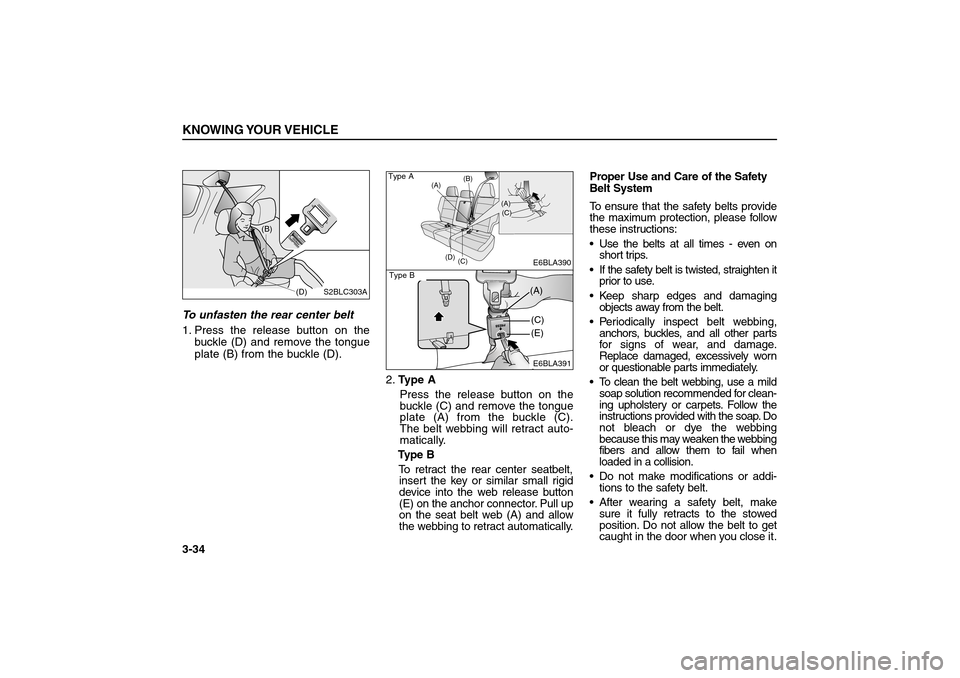
To unfasten the rear center belt
1. Press the release button on the
buckle (D) and remove the tongue
plate (B) from the buckle (D).
2.Type A
Press the release button on the
buckle (C) and remove the tongue
plate (A) from the buckle (C).
The belt webbing will retract auto-
matically.
Type B
To retract the rear center seatbelt,
insert the key or similar small rigid
device into the web release button
(E) on the anchor connector. Pull up
on the seat belt web (A) and allow
the webbing to retract automatically.Proper Use and Care of the Safety
Belt System
To ensure that the safety belts provide
the maximum protection, please follow
these instructions:
Use the belts at all times - even on
short trips.
If the safety belt is twisted, straighten it
prior to use.
Keep sharp edges and damaging
objects away from the belt.
Periodically inspect belt webbing,
anchors, buckles, and all other parts
for signs of wear, and damage.
Replace damaged, excessively worn
or questionable parts immediately.
To clean the belt webbing, use a mild
soap solution recommended for clean-
ing upholstery or carpets. Follow the
instructions provided with the soap. Do
not bleach or dye the webbing
because this may weaken the webbing
fibers and allow them to fail when
loaded in a collision.
Do not make modifications or addi-
tions to the safety belt.
After wearing a safety belt, make
sure it fully retracts to the stowed
position. Do not allow the belt to get
caught in the door when you close it.KNOWING YOUR VEHICLE3-34
(D) (B)P
R
E
S
S
S2BLC303A
(A)
(A)
(C) (B)
(D)
(C)
(A)
(C)(E)E6BLA390E6BLA391
Type AType B
BL-ENG (CAN)-3.qxd 7/28/05 5:52 PM Page 34
Page 44 of 312
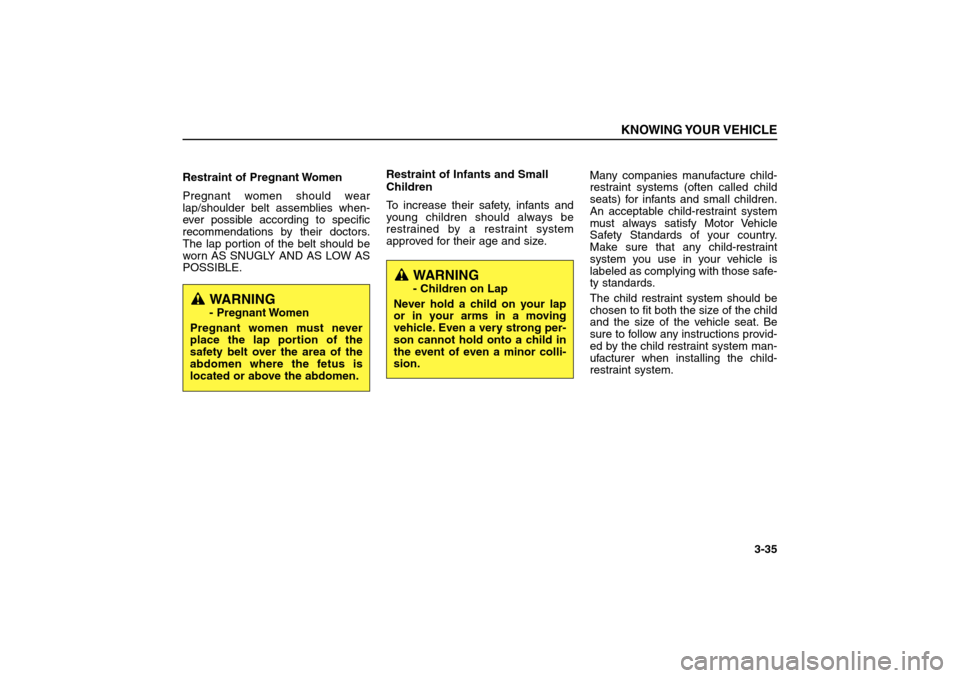
Restraint of Pregnant Women
Pregnant women should wear
lap/shoulder belt assemblies when-
ever possible according to specific
recommendations by their doctors.
The lap portion of the belt should be
worn AS SNUGLY AND AS LOW AS
POSSIBLE.Restraint of Infants and Small
Children
To increase their safety, infants and
young children should always be
restrained by a restraint system
approved for their age and size.Many companies manufacture child-
restraint systems (often called child
seats) for infants and small children.
An acceptable child-restraint system
must always satisfy Motor Vehicle
Safety Standards of your country.
Make sure that any child-restraint
system you use in your vehicle is
labeled as complying with those safe-
ty standards.
The child restraint system should be
chosen to fit both the size of the child
and the size of the vehicle seat. Be
sure to follow any instructions provid-
ed by the child restraint system man-
ufacturer when installing the child-
restraint system.
KNOWING YOUR VEHICLE
3-35
WARNING- Pregnant Women
Pregnant women must never
place the lap portion of the
safety belt over the area of the
abdomen where the fetus is
located or above the abdomen.
WARNING- Children on Lap
Never hold a child on your lap
or in your arms in a moving
vehicle. Even a very strong per-
son cannot hold onto a child in
the event of even a minor colli-
sion.
BL-ENG (CAN)-3.qxd 7/28/05 5:52 PM Page 35
Page 45 of 312
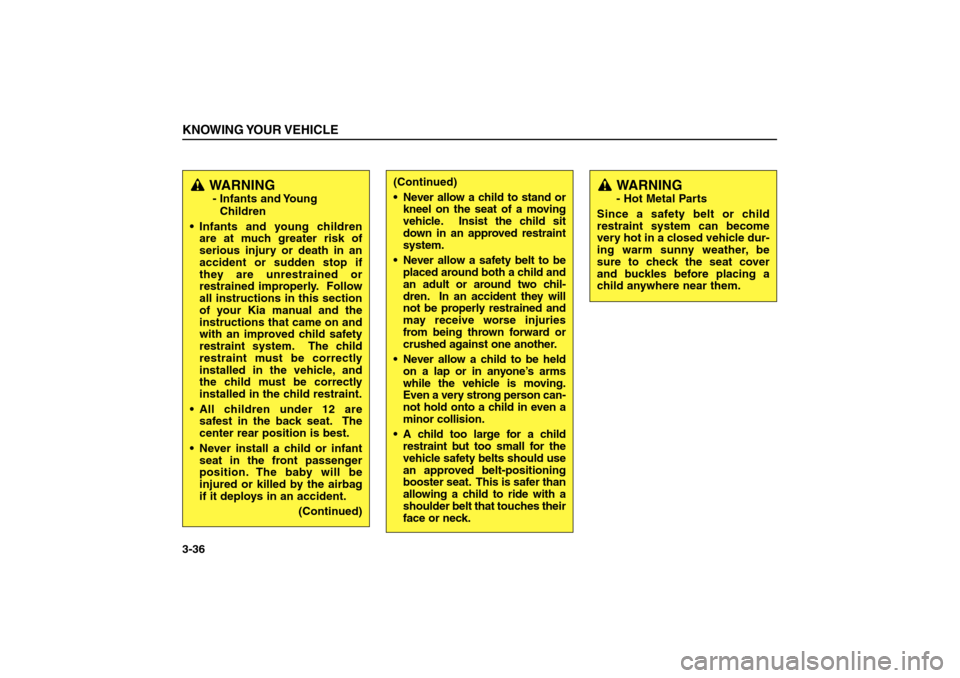
KNOWING YOUR VEHICLE3-36
WARNING- Infants and Young
Children
Infants and young children
are at much greater risk of
serious injury or death in an
accident or sudden stop if
they are unrestrained or
restrained improperly. Follow
all instructions in this section
of your Kia manual and the
instructions that came on and
with an improved child safety
restraint system. The child
restraint must be correctly
installed in the vehicle, and
the child must be correctly
installed in the child restraint.
All children under 12 are
safest in the back seat. The
center rear position is best.
Never install a child or infant
seat in the front passenger
position. The baby will be
injured or killed by the airbag
if it deploys in an accident.
(Continued)
(Continued)
Never allow a child to stand or
kneel on the seat of a moving
vehicle. Insist the child sit
down in an approved restraint
system.
Never allow a safety belt to be
placed around both a child and
an adult or around two chil-
dren. In an accident they will
not be properly restrained and
may receive worse injuries
from being thrown forward or
crushed against one another.
Never allow a child to be held
on a lap or in anyone’s arms
while the vehicle is moving.
Even a very strong person can-
not hold onto a child in even a
minor collision.
A child too large for a child
restraint but too small for the
vehicle safety belts should use
an approved belt-positioning
booster seat. This is safer than
allowing a child to ride with a
shoulder belt that touches their
face or neck.
WARNING- Hot Metal Parts
Since a safety belt or child
restraint system can become
very hot in a closed vehicle dur-
ing warm sunny weather, be
sure to check the seat cover
and buckles before placing a
child anywhere near them.
BL-ENG (CAN)-3.qxd 7/28/05 5:52 PM Page 36
Page 46 of 312
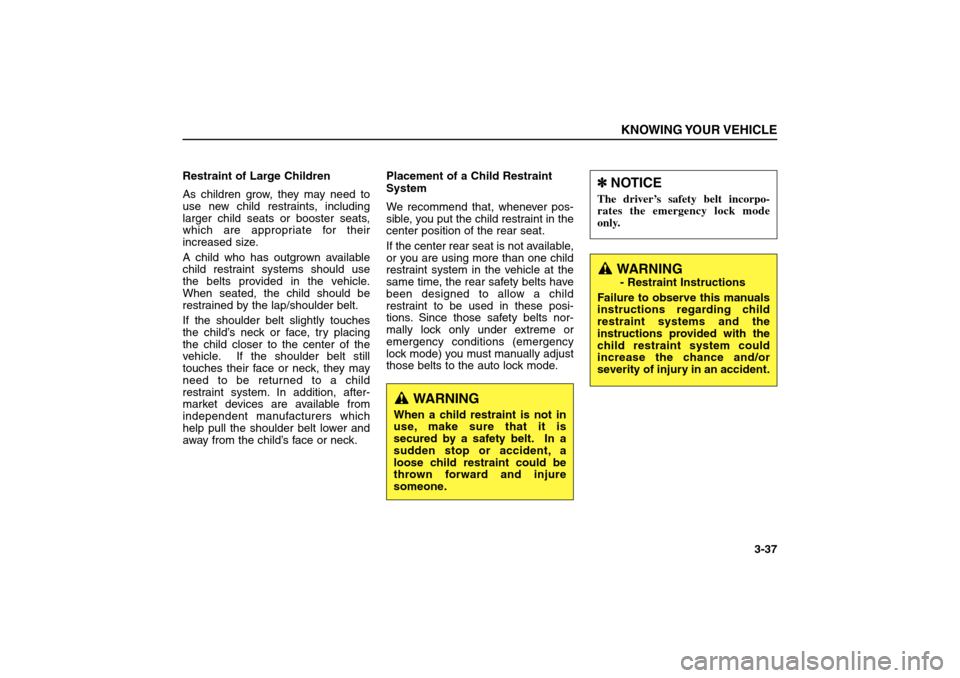
Restraint of Large Children
As children grow, they may need to
use new child restraints, including
larger child seats or booster seats,
which are appropriate for their
increased size.
A child who has outgrown available
child restraint systems should use
the belts provided in the vehicle.
When seated, the child should be
restrained by the lap/shoulder belt.
If the shoulder belt slightly touches
the child’s neck or face, try placing
the child closer to the center of the
vehicle. If the shoulder belt still
touches their face or neck, they may
need to be returned to a child
restraint system. In addition, after-
market devices are available from
independent manufacturers which
help pull the shoulder belt lower and
away from the child’s face or neck.Placement of a Child Restraint
System
We recommend that, whenever pos-
sible, you put the child restraint in the
center position of the rear seat.
If the center rear seat is not available,
or you are using more than one child
restraint system in the vehicle at the
same time, the rear safety belts have
been designed to allow a child
restraint to be used in these posi-
tions. Since those safety belts nor-
mally lock only under extreme or
emergency conditions (emergency
lock mode) you must manually adjust
those belts to the auto lock mode.
KNOWING YOUR VEHICLE
3-37
WARNING
When a child restraint is not in
use, make sure that it is
secured by a safety belt. In a
sudden stop or accident, a
loose child restraint could be
thrown forward and injure
someone.
✽ ✽
NOTICEThe driver’s safety belt incorpo-
rates the emergency lock mode
only.
WARNING- Restraint Instructions
Failure to observe this manuals
instructions regarding child
restraint systems and the
instructions provided with the
child restraint system could
increase the chance and/or
severity of injury in an accident.
BL-ENG (CAN)-3.qxd 7/28/05 5:52 PM Page 37
Page 47 of 312
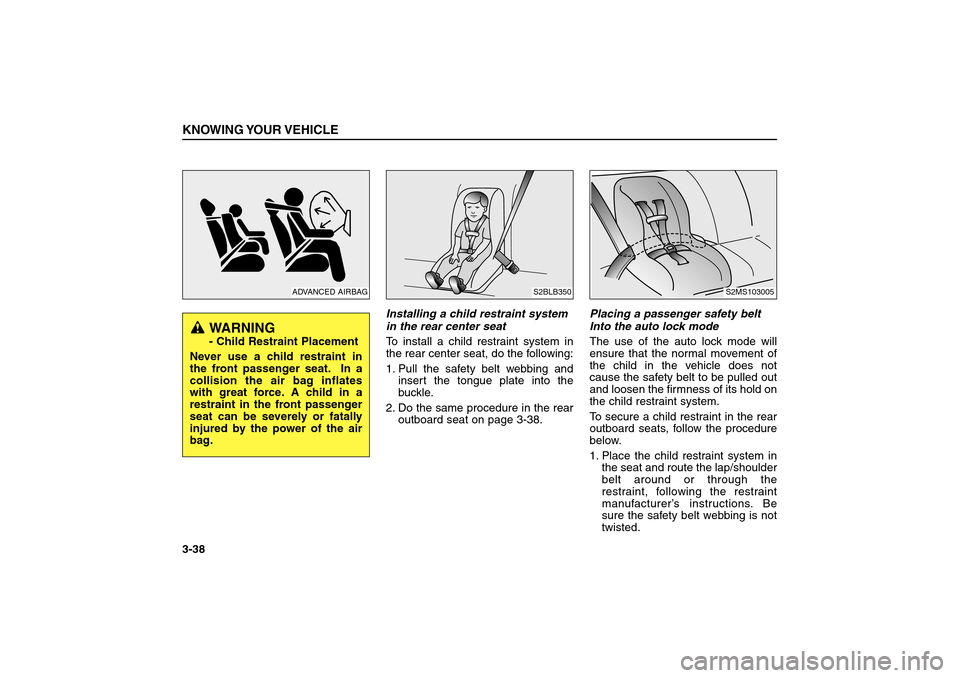
Installing a child restraint system
in the rear center seat
To install a child restraint system in
the rear center seat, do the following:
1. Pull the safety belt webbing and
insert the tongue plate into the
buckle.
2. Do the same procedure in the rear
outboard seat on page 3-38.Placing a passenger safety belt
Into the auto lock mode
The use of the auto lock mode will
ensure that the normal movement of
the child in the vehicle does not
cause the safety belt to be pulled out
and loosen the firmness of its hold on
the child restraint system.
To secure a child restraint in the rear
outboard seats, follow the procedure
below.
1. Place the child restraint system in
the seat and route the lap/shoulder
belt around or through the
restraint, following the restraint
manufacturer’s instructions. Be
sure the safety belt webbing is not
twisted.
KNOWING YOUR VEHICLE3-38
ADVANCED AIRBAG
WARNING- Child Restraint Placement
Never use a child restraint in
the front passenger seat. In a
collision the air bag inflates
with great force. A child in a
restraint in the front passenger
seat can be severely or fatally
injured by the power of the air
bag.
S2BLB350
S2MS103005
BL-ENG (CAN)-3.qxd 7/28/05 5:52 PM Page 38
Page 48 of 312
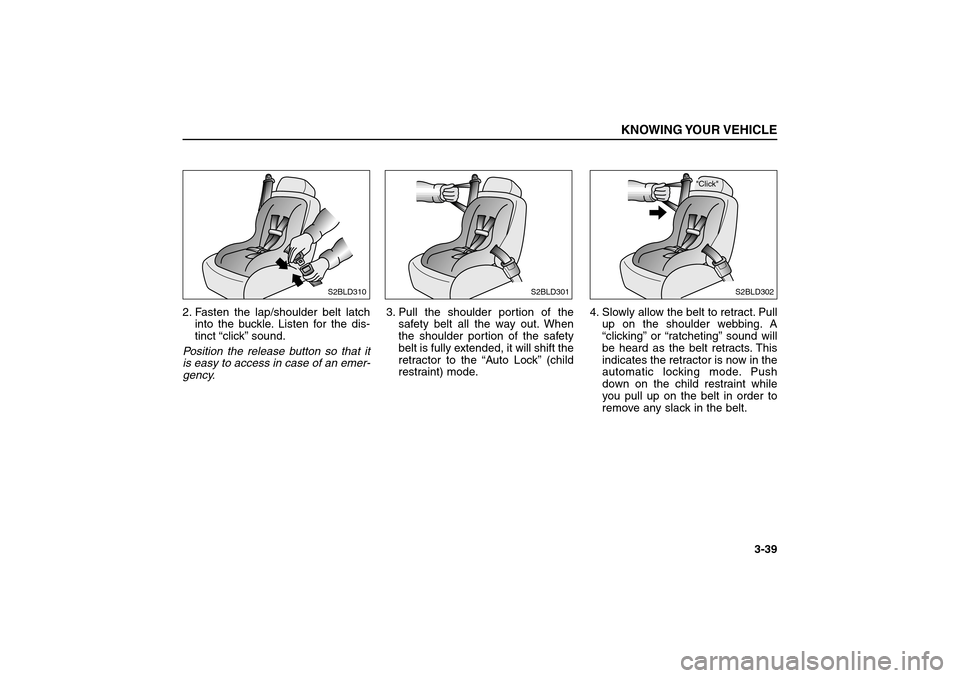
2. Fasten the lap/shoulder belt latch
into the buckle. Listen for the dis-
tinct “click”sound.
Position the release button so that it
is easy to access in case of an emer-
gency.3. Pull the shoulder portion of the
safety belt all the way out. When
the shoulder portion of the safety
belt is fully extended, it will shift the
retractor to the “Auto Lock”(child
restraint) mode.4. Slowly allow the belt to retract. Pull
up on the shoulder webbing. A
“clicking”or “ratcheting”sound will
be heard as the belt retracts. This
indicates the retractor is now in the
automatic locking mode. Push
down on the child restraint while
you pull up on the belt in order to
remove any slack in the belt.
KNOWING YOUR VEHICLE
3-39
S2BLD301
S2BLD310
"Click"
S2BLD302
BL-ENG (CAN)-3.qxd 7/28/05 5:52 PM Page 39
Page 49 of 312
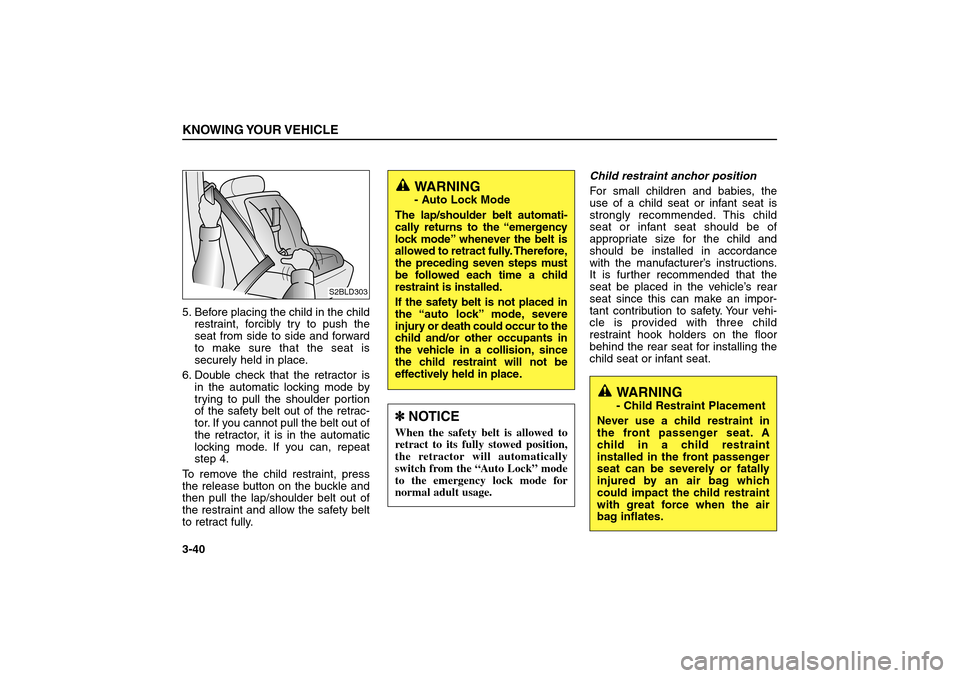
5. Before placing the child in the child
restraint, forcibly try to push the
seat from side to side and forward
to make sure that the seat is
securely held in place.
6. Double check that the retractor is
in the automatic locking mode by
trying to pull the shoulder portion
of the safety belt out of the retrac-
tor. If you cannot pull the belt out of
the retractor, it is in the automatic
locking mode. If you can, repeat
step 4.
To remove the child restraint, press
the release button on the buckle and
then pull the lap/shoulder belt out of
the restraint and allow the safety belt
to retract fully.Child restraint anchor position
For small children and babies, the
use of a child seat or infant seat is
strongly recommended. This child
seat or infant seat should be of
appropriate size for the child and
should be installed in accordance
with the manufacturer’s instructions.
It is further recommended that the
seat be placed in the vehicle’s rear
seat since this can make an impor-
tant contribution to safety. Your vehi-
cle is provided with three child
restraint hook holders on the floor
behind the rear seat for installing the
child seat or infant seat.KNOWING YOUR VEHICLE3-40
WARNING- Auto Lock Mode
The lap/shoulder belt automati-
cally returns to the “emergency
lock mode” whenever the belt is
allowed to retract fully. Therefore,
the preceding seven steps must
be followed each time a child
restraint is installed.
If the safety belt is not placed in
the “auto lock” mode, severe
injury or death could occur to the
child and/or other occupants in
the vehicle in a collision, since
the child restraint will not be
effectively held in place.
✽ ✽
NOTICEWhen the safety belt is allowed to
retract to its fully stowed position,
the retractor will automatically
switch from the “Auto Lock” mode
to the emergency lock mode for
normal adult usage.
WARNING- Child Restraint Placement
Never use a child restraint in
the front passenger seat. A
child in a child restraint
installed in the front passenger
seat can be severely or fatally
injured by an air bag which
could impact the child restraint
with great force when the air
bag inflates.
S2BLD303
BL-ENG (CAN)-3.qxd 7/28/05 5:52 PM Page 40
Page 50 of 312
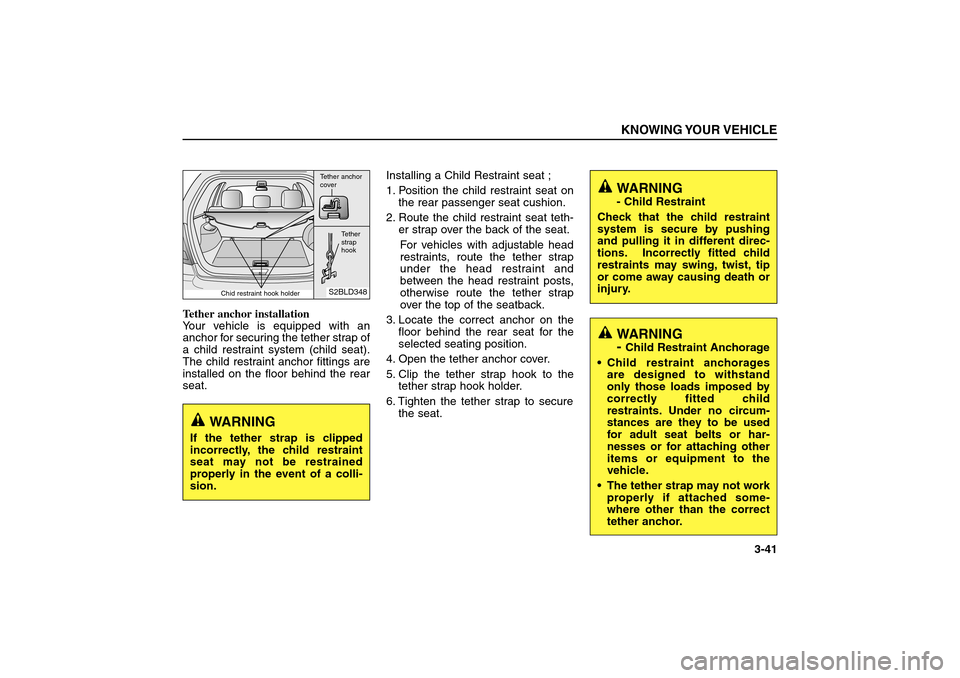
Tether anchor installation
Your vehicle is equipped with an
anchor for securing the tether strap of
a child restraint system (child seat).
The child restraint anchor fittings are
installed on the floor behind the rear
seat.Installing a Child Restraint seat ;
1. Position the child restraint seat on
the rear passenger seat cushion.
2. Route the child restraint seat teth-
er strap over the back of the seat.
For vehicles with adjustable head
restraints, route the tether strap
under the head restraint and
between the head restraint posts,
otherwise route the tether strap
over the top of the seatback.
3. Locate the correct anchor on the
floor behind the rear seat for the
selected seating position.
4. Open the tether anchor cover.
5. Clip the tether strap hook to the
tether strap hook holder.
6. Tighten the tether strap to secure
the seat.
KNOWING YOUR VEHICLE
3-41
S2BLD348
WARNING - Child Restraint
Check that the child restraint
system is secure by pushing
and pulling it in different direc-
tions. Incorrectly fitted child
restraints may swing, twist, tip
or come away causing death or
injury.
WARNING
If the tether strap is clipped
incorrectly, the child restraint
seat may not be restrained
properly in the event of a colli-
sion.
WARNING
- Child Restraint Anchorage
Child restraint anchorages
are designed to withstand
only those loads imposed by
correctly fitted child
restraints. Under no circum-
stances are they to be used
for adult seat belts or har-
nesses or for attaching other
items or equipment to the
vehicle.
The tether strap may not work
properly if attached some-
where other than the correct
tether anchor.
Tether anchor
cover
Tether
strap
hook
Chid restraint hook holder
BL-ENG (CAN)-3.qxd 7/28/05 5:52 PM Page 41